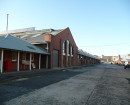Wilsons Promontory Lightstation
WILSONS PROMONTORY, South Gippsland Shire
-
Add to tour
You must log in to do that.
-
Share
-
Shortlist place
You must log in to do that.
- Download report




Statement of Significance
Wilsons Promontory Lightstation was constructed in 1858-59 from locally quarried honey-coloured granite to the design of Victorian Public Works Department architect Charles Maplestone. It is part of a group that includes Cape Schanck and Gabo Island and which formed the second campaign of lighthouse building in Victorian waters. The buildings remaining from 1859 include the rock faced granite tower, head lightkeeper's quarters and associated stone walls. The original assistant keepers' duplex quarters were lost in the disastrous 1951 fire that swept across the station. Two brick residence were built shortly after the fire and there is also a 1923 brick residence. The lighthouse, which was originally painted white, is now unpainted and has had its original lantern house replaced. The lightstation occupies its own promontory of land on South East Point some distance to the east of the pitch of Wilsons Promontory. During the Second World War there was a radar station of which there are remnants of concrete buildings. Because of its layout with the light tower at the end of a stone walled street, the lightstation has the most village-like feel of all the Victorian lightstations where the normal approach was to lay out the buildings in a line as at Gabo Island, or dispersed at at Cape Schanck.
How is it significant?
Wilsons Promontory Lightstation is of historical, architectural and archaeological significance to the State of Victoria.
Why is it significant?
Wilsons Promontory Lightstation is historically important as a key component in a series of navigational aids which served to make safe the passage of Bass Strait. It was built as a direct result of the 1856 inter-colonial conference of maritime officers, and as such it is an important manifestation of a growing co-operation between the colonies in the field of maritime safety.
Wilsons Promontory Lightstation is architecturally important as a fine example of the lighthouse design work of Charles Maplestone, the architect for all Victorian lights between 1856 and 1861. While its integrity has suffered from the loss of the assistants' quarters in 1951 and the tower's original lantern house in 1975, the lightstation retains much of its important early fabric.
Wilsons Promontory Lightstation is archaeologically significant for its potential to reveal artefactual remains principally in the form of building remnants from earlier lightstation and signal station buildings, but also military remnants from the use of the place as a wartime radar station.
-
-
Wilsons Promontory Lightstation - Physical Description 1
from Ivar Nelsen, Patrick Miller and Terry Sawyer Conservation Management Plan December 1993
The Lightstation encompasses an area at the south-eastern tip of Wilsons Promontory and adjoins the Wilsons Promontory National Park. Wilsons Promontory is formed of granite overlaid by sand dunes. The dunes are covered with a rich variety of vegetation and the Wilsons Promontory National Park is one of Victoria's largest and most popular national parks.
The lightstation reserve is situated on an elevated point with rocky cliffs at its perimeter. There are small bays at either side of the neck of the point which offer difficult access to small craft. The western bay has a disused crane near the water line while the eastern bay has steps cut into the rocks down to the water line, a landing and store.
The Lighthouse Precinct occupies the south-eastern tip of the promontory. It consists of a granite residence and lighthouse, two brick residences, a cement brick residence, a concrete block garage and workshop, a brick powerhouse and two sheet metal sheds. The lighthouse and residences with their outbuildings form a tight group in a lineal formation. The garage/workshop, sheds and the red brick powerhouse are visually intrusive elements.
The lighthouse is a coursed granite structure which terminates in a balcony with railing and the whole is surmounted with a modern lantern. The light was converted to an 18 mile solar powered light in July 1993. The automatic beacon has replaced the sealed beam array in the lantern room.
The head keeper's residence is a stone residence with verandahs (open and enclosed) to all elevations. The most prominent features are the stone chimneys and timber verandahs.
The assistant keeper's residence is a relatively recently constructed cement brick residence with a Colorbond gable roof. This a simple utilitarian residence of the period with no particular outstanding features. A smaller residence was constructed in 1953 was used to accommodate relief keepers and AMSA employees. It is constructed of brick with a gable roof.
The former Assistant Keeper's residence of 1924 has a gabled fibro cement roof and a built-in verandah to the western side. The residence remains substantially as constructed in 1924.
There is an office, watchroom and store attached to the base of the tower. The concrete portion of this building has not been accurately dated but appears to be a World War 2 era structure. The southern watchroom addition was designed in 1968 and presumably built shortly after. There are some concrete remnants of Second World War buildings associated with the radar station.
The landing is a structure of relatively modern origins on the site traditionally used as one of the two landings at Wilsons Promontory. It is the most sheltered landing place in the vicinity of the point when the prevailing westerlies are blowing. A concrete ramp has been constructed on a portion of the rocks at the base of the landing to allow access to the lightstation by the amphibious vehicles.
Heritage Inventory Feature:
863/0001
Material:3320
Subdivision material: 0199
Metal valve 1 1/2' flow. Simple metal swinging plate for one way flow. Large hexagonal purchase on top plate for removal. Raised print includes a direction arrow 'John, 1 1/2, F1?,4B' - thread 3.3mm gap
Thread diameter: 45mm
Length: 125mm
Height: 113mm
Material: copper alloy
Finder: R. Blackwell
Date: 16/08/96Wilsons Promontory Lightstation - Usage/Former Usage
1857-1859 ; navigation aid ;
Veterans Description for Public
Wilsons Promontory Lightstation - Veterans Description for Public
The Wilsons Promontory Lightstation was constructed in 1858-59 from locally quarried honey-coloured granite to the design of Victorian Public Works Department architect Charles Maplestone. It was built as a direct result of the 1856 inter-colonial conference of maritime officers, and as such it is an important manifestation of a growing co-operation between the colonies in the field of maritime safety. From about 1938 until the end of the Second World War the national park was closed to the public and a small naval contingent and commando units trained there. A radar station manned by air force personnel was constructed in the vicinity of the lighthouse station. The men were housed in corrugated iron huts to the north east of the assistants' quarters. A fire in 1951 destroyed much of the station, but remnants survive of the concrete buildings that comprised a radar station during the Second World War.
Wilsons Promontory Lightstation - Permit Exemption Policy
/nLightstations are special places with a special ambience. While they have great appeal for visitation and high tourist potential, overdevelopment is highly undesirable and should be avoided. Conservation plans have been developed for most lightstations which give guidance for the physical treatment of buildings and features. Within the constraints inherent in managing what are fairly delicate places, there remain opportunities to enhance the physical fabric by appropriate conservation works and to retrieve former bad practice.
-
-
-
-
-
WILSONS PROMONTORY LIGHTSTATION
 Victorian Heritage Register H1842
Victorian Heritage Register H1842 -
LIGHTHOUSE QUARRY
 Victorian Heritage Inventory
Victorian Heritage Inventory -
Wilsons Promontory Lightstation
 Vic. War Heritage Inventory H1842
Vic. War Heritage Inventory H1842
-
'Altona' Homestead (Formerly 'Laverton' Homestead) and Logan Reserve
 Hobsons Bay City
Hobsons Bay City
-
-











